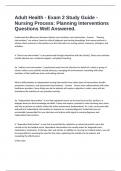Adult Health - Exam 2 Study Guide -
Nursing Process: Planning Interventions
Questions Well Answered.
Understand the differences between indirect-care and direct care intervention - Answer *Nursing
interventions* are actions, based on clinical judgment and nursing knowledge, that nurses perform to
achieve client outcomes. Interventions are also referred to as nursing actions, measures, strategies, and
activities.
A *direct-care intervention* is one performed through interaction with the client(s). Direct-care activities
include physical care, emotional support, and patient teaching.
An *indirect care intervention* is performed away from the client but on behalf of a client or group of
clients. Indirect care activities include advocacy, managing the environment, consulting with other
members of the healthcare team, and making referrals.
What is differentiates an independent nursing intervention from other types of interventions (health
promotion, treatment, and assessment interventions). - Answer Nurses work collaboratively with other
healthcare providers. Some things you do for patients will require a physician's order; many will not.
Sometimes the activities of care providers overlap.
An *independent intervention* is one that registered nurses are licensed to prescribe, perform, or
delegate based on their knowledge and skills. It does not require a provider's order. Knowing how, when,
and why to perform an activity makes the action autonomous (independent). As a rule, nurses prescribe
and perform independent interventions in response to a nursing diagnosis. Understand you are
accountable (answerable) for your decisions and actions with regard to nursing diagnoses and
independent interventions.
A *dependent intervention* is one that is prescribed by a physician or advanced practice nurse but
carried out by the bedside nurse. Dependent interventions are usually orders for diagnostic tests,
medications, treatments, IV therapy, diet, and activity. In addition to carrying out medical orders, you will
be responsible for assessing the need for the order, explaining the activities to the patient, and
evaluating the effectiveness
of the order.
, An *interdependent (collaborative) intervention* is one that is carried out in collaboration with other
health team members (e.g., physical therapists, dietitians, and physicians). Because
nurses care for the whole person, their responsibilities often overlap with those of other team members.
Understand critical pathways, clinical practice guidelines and evidenced reports - Answer *Critical
pathways* (also called clinical pathways and collaborative care plans) are standardized plans of care for
frequently occurring conditions (e.g., total hip replacement) for which similar outcomes and
interventions are appropriate for all patients who have the condition. They are tools developed by an
organization for its own use and are intended to guide best practice at the local level. However, they may
not be based on research if the practitioners who develop them are reluctant to change traditional
practices they believe to be effective. Furthermore, issues of cost to the organization infl uence the
decision to include an intervention in the plan of care. Nevertheless, critical pathways provide a guide for
nursing interventions in that, at the very least, they have been developed on the basis of expert opinion.
*Evidence reports* are state-of-the-art, systematic reviews of clinical topics for the purpose of providing
evidence for practice guidelines, quality improvement, quality measures, and insurance coverage
decisions (Cronenwett, 2002). Evidence reports are usually developed by scientists rather than clinicians,
patients, and advocacy groups. Two sources of such reports are (1) the Registered Nurses' Association of
Ontario, Canada and (2) the Evidence-Based Practice Center (EPC) Program of the federal Agency for
Healthcare Research and Quality (AHRQ). The EPC uses explicit grading systems to review studies and
rank the strength of their evidence.
Evidence reports often form the basis for developing clinical practice guidelines. *Clinical practice
guidelines* are systematically developed statements to assist practitioners and patients in making
decisions about appropriate healthcare for a particular disease or procedure (Institute of Medicine,
1992). Clinical practice guidelines are usually developed b
Who is the primary decision maker in the care of healthy clients? Understand that family can give input
but it is the patient who makes the decisions if they are capable and competent. - Answer As in all
phases of the nursing process, think of the client as a collaborative partner. Encourage the client and
family to participate as much as possible in the client's care. Be aware that clients vary in their ability and
desire to participate. Typically, the client implements health-promotion interventions, with little or no
involvement by the nurse. To obtain the most benefit from an intervention, a client must be physically
and psychologically ready. Clients are collaborative partners, not passive recipients of your care. Many
interventions require their participation or cooperation. The following are caring reasons for taking time
to explain.
■ Explaining the reasons for the action helps to motivate the person to participate.




